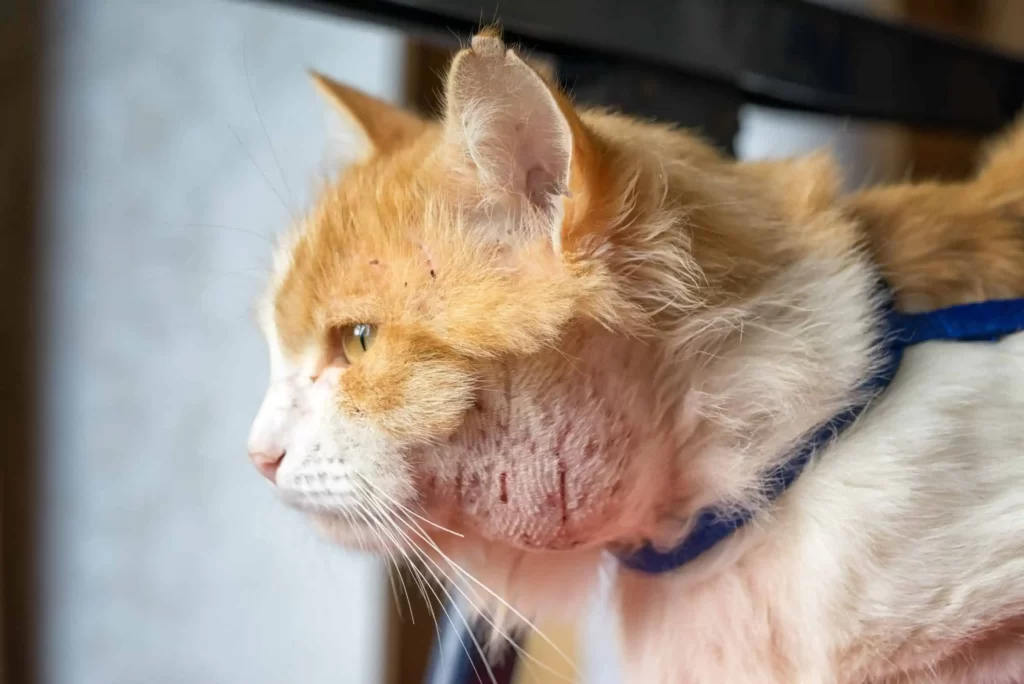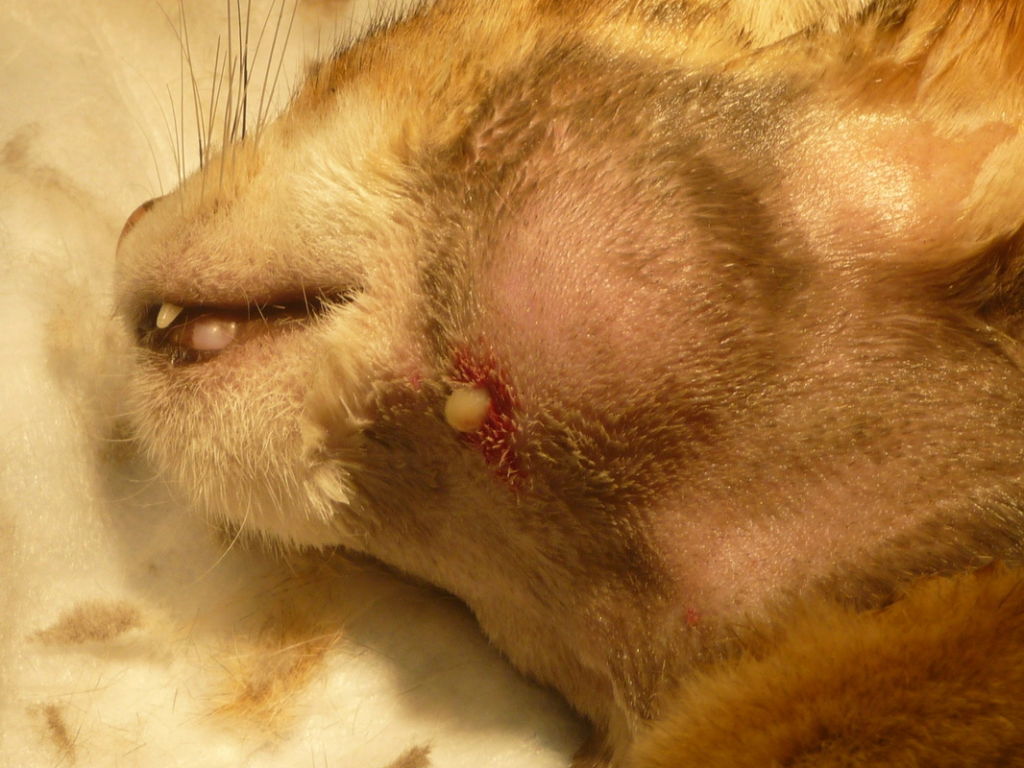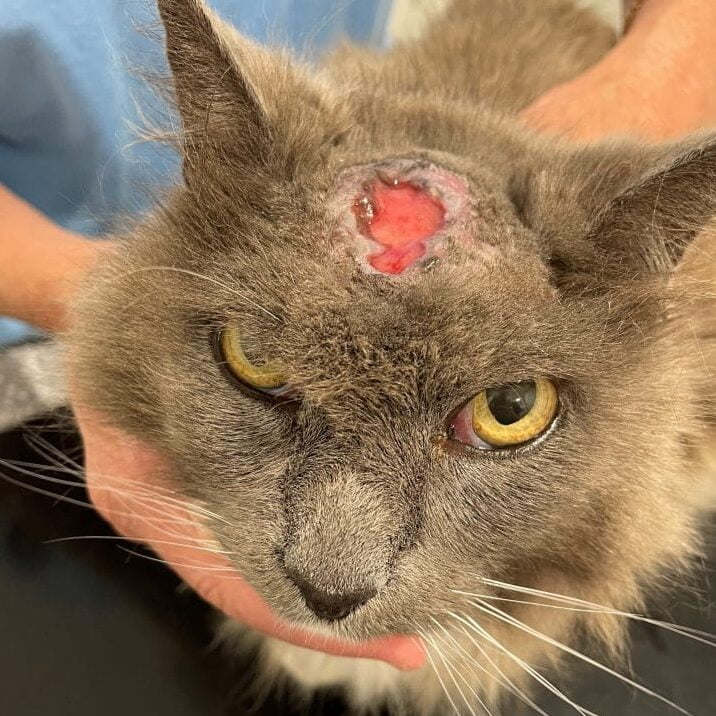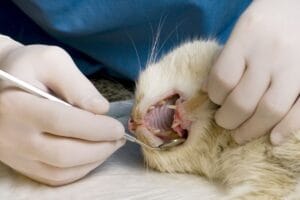How to Treat a Cat Abscess at Home (The Safe Way)

This article will provide a comprehensive overview on how to treat a Cat Abscess at home.
Abscesses in cats are a common occurrence and can be caused by a variety of factors. This includes bites, scratches from other cats, or skin infections. They are characterized by a painful, swollen lump on the skin that is filled with pus.
If left untreated, abscesses can lead to serious complications and should be taken care of as soon as possible. Oh, and don’t worry. Cat Abscesses are not contagious to humans, so relax. You’re safe.
When dealing with a cat abscess, it is best to seek the help of a veterinarian. However, there may be times when this is not possible, and it is important to know how to handle the situation at home. Knowing the proper care and treatment can help alleviate your cat’s symptoms. This can also prevent the abscess from worsening until you can get the proper medical attention.
Causes of Cat Abscesses:
Common causes for Cat Abscesses include the following reasons.
- Fights with other cats: Cats are known for their territorial nature. Due to this they may engage in fights with other cats in their vicinity. These fights can lead to bites and scratches which can become infected and develop into an abscess.
- Bacterial infections: Abscesses can also be caused by bacterial infections. They can enter the body through a small wound or scratch. This is why it is important to clean out your cat’s wounds, to prevent a possible abscess.
- Injuries or Trauma: Abscesses can also occur as a result of injuries or trauma to the skin, such as being hit by a car or getting stuck in a fence. Skin-penetrating objects such as a sharp stick can also be the cause.
- Abscesses secondary to other underlying conditions: In some cases, abscesses can develop as a result of underlying medical conditions that compromise the cat’s immune system. These conditions may include dental disease, autoimmune disorders, or other infections.

Symptoms of Cat Abscesses:
Common symptoms found in Cats with abscesses.
- Swollen, painful lump on the skin
- Redness and warmth in the affected area
- Pus or other discharge from the wound
- Loss of appetite
- Lethargy or depression
- Excessive itching
- Difficulty sleeping
- Foul odor coming from the wound
If the abscess is located under the skin (internally), you may notice an indentation when pressure is applied to the area of swelling. Cats can get abscesses almost anywhere on their bodies, such as the paws, back, head, and even on their gums. Some may not be as visible as the others, so its important to close monitor your cat.
Common Stages of Cat Abscess Formation and Healing:
The healing stages of a cat abscess typically look something like this:
- Abscess formation: The first stage of a cat abscess is the formation of a swelled up area. This occurs as a result of an infection introduced into the skin, typically through a bite or scratch wound. The body’s immune response leads to the accumulation of pus in a localized pocket, causing the area to become swollen and painful.
- Pus and blood leakage: As the abscess progresses, the pressure from the accumulated pus may cause the abscess to rupture or leak. This can result in the discharge of pus and, in some cases, blood. The leakage is a sign that the abscess is reaching a critical stage and requires immediate attention.
- Bursting of the abscess: When the abscess reaches a point of maximum pressure, it will often burst open. This can happen spontaneously or as a result of external pressure or trauma to the area. The bursting of the abscess releases the accumulated pus and relieves the pressure, providing some relief to the cat.
- Drainage of pus: After the abscess bursts, the pus will continue to drain from the wound. It is important to keep the wound clean and provide proper drainage to ensure the removal of all pus and debris. This can be achieved through gentle cleansing and the use of warm saline solution or as recommended by a veterinarian.
- Wound care and healing: Once the pus has been drained, the focus shifts to wound care and promoting natural healing. This involves keeping the wound clean, free from debris, and applying appropriate wound dressings as recommended by a veterinarian. With proper care, the wound will begin to heal naturally, similar to a normal wound, by the growth of new tissue and the gradual closure of the wound.
Treating a Cat Abscess at Home
The key to treating a Cat abscess is to “pop” the swelled area and drain away all of the pus and external discharge. IT IS NOT recommended that you try this popping the abscess yourself at home. The abscess will either pop by itself naturally over time, or you can go to the Vet to have them pop it (under sedation).
Regardless, if you are looking for a safe way to “pop” the abscess at home, you can use a warm compress to gently apply heat to the abscess for 10 minutes a few times a day. Ensure that the water is not too hot as it may burn the cat. If it’s too hot for your hands, it’s too hot for your cat. You may need to reheat the compress a few times to maintain warmth on the affected area.
A heated compress has various benefits. The heat from the compress helps to increase blood flow to the affected area, which can speed up the healing process. The warmth also helps to soften and bring the abscess to a head, making it easier for the pus to drain out. Additionally, the heat can help to reduce pain and discomfort for the cat.
Once again: Do not attempt to forcefully pop and drain the abscess.
How to Treat a Burst Cat Abscess
A cat abscess that has already burst open (either naturally or by accident) can be treated using a variety of home treatment options. Outlined below are all the steps needed to safely care for and treat a cat abscess at home.

1) Preparing the Wound for Treatment
Ensure that the wound is clean of any obstructions or debris. If the abscess was caused by a penetrating object such as a wooden stick, ensure that all pieces of it are removed. Otherwise, the abscess will eventually return. If the cat’s fur is obstructing your view, clip or trim it.
If there is any minor swelling remaining with some pus, you can try gently pressing on the affected area to drain it. This step can be quite tricky, however, as the Cat will experience a lot of discomfort. You can opt to skip this step and clean out the wound directly as directed in Step 2.
2) Cleaning out the Wound
Clean out the wound of all the remaining discharge using a saline solution (or something similar). Cat wounds heal from the outside, meaning that if you do not keep the wound clean at all times, the infection could get trapped inside as the cat’s skin grows back.
You need to be very gentle while cleaning the wound because the abscess makes the surrounding area more sensitive for the cat. Gently dab the cat (no rubbing), or pour the cleaning solution over the wound.
NOTE: Hydrogen peroxide is often used for treating wounds, but it NOT recommended for Cat abscesses as it can actually have the opposite effect. Use sterile saline instead, or make your own homemade solution.
3) Apply anti-biotics (Vet approved)
Once the wound is clean, you can begin applying any anti-biotics your Vet may have prescribed. You don’t necessarily have to take your Cat to the Vet for this (though that would be preferable).
Your Vet will give you the proper instructions and method of administrating the antibiotic. This is typically some form of ointment which needs to be lightly and gently applied to the wound, applied over a duration of about two weeks.
There are also several home remedies that can be used alongside vet-suggested remedies. A common home remedy is “Aloe Vera”, which helps reduce inflammation, promote tissue repair, and provide relief from discomfort. To use this, apply a thin layer of pure and organic aloe vera gel on the abscess. Ensure that the gel does not contain any additional additives or ingredients that may be harmful to cats.
4) Monitor the wound
Now you need to carefully observe and ensure the recovery process goes smoothly. Make sure your cat does not lick the wound, as their saliva contains bacteria that could worsen the infection. If the wound is in a place which your cats licks frequently, consider getting a cone collar.
Remember to regularly clean and treat the abscess-affected area of your Cat at home. The recovery period for an abscess varies between 1 to 3 weeks. The recovery speed varies based on the Cats health, environment (outdoor or indoor), age, location of abscess, and its severity.
If the situation worsens or shows no sign of improvement after several days, then contact a Vet immediately and seek professional help.
Preventing Cat Abscesses:
Preventing cat abscesses is an essential part of maintaining your cat’s health and well-being. Here are some tips to help reduce the risk of abscesses in cats:
Keep Cats Indoors: Cats that stay indoors are generally at a lower risk of encountering situations that can lead to fights or injuries. Indoor cats are less likely to come into contact with other cats that may transmit diseases or engage in aggressive behavior. By providing a safe and enriched indoor environment, you can minimize the risk of abscesses caused by fights or territorial disputes.
Regular Grooming: Regularly grooming your cat helps maintain healthy skin and coat. It allows you to identify any wounds or skin infections early on, reducing the likelihood of abscess development. Brushing your cat’s fur removes loose hair, dirt, and debris, preventing them from accumulating and causing skin irritations or infections.
Vaccinations: Ensure that your cat’s vaccinations are up to date. Vaccinations can help protect against certain diseases, including those transmitted through fights with other cats. By keeping your cat’s immunizations current, you reduce the risk of infections that can lead to abscess formation.
Environmental Enrichment: Providing a stimulating environment with plenty of toys, scratching posts, and climbing opportunities can help reduce stress and prevent aggressive behavior. Engaging your cat in interactive play sessions can redirect their energy and prevent them from engaging in fights or territorial disputes with other cats.
Prompt Wound Care: If your cat sustains a minor wound or scratch, it is essential to clean it promptly to prevent infection. Use a mild antiseptic solution recommended by your veterinarian or a saline solution to gently clean the wound. Keeping the wound clean reduces the risk of bacteria entering and causing an abscess.
By implementing these preventive measures, you can significantly reduce the chances of your cat developing abscesses and promote their overall health and well-being. However, if you notice any signs of injury or illness, it is important to consult with a veterinarian for proper diagnosis and treatment.
We hope you find our guide on how to treat a cat abscess at home, useful and informative.


